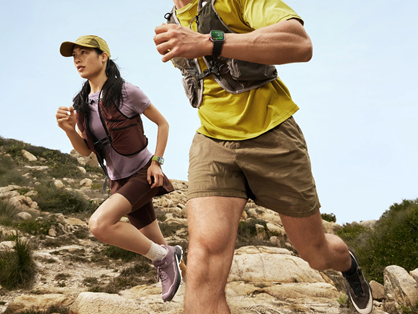Fitness tracking technology has undergone a remarkable transformation in recent years. What began as simple step counters has evolved into sophisticated multi-sport companions capable of recognizing and recording dozens of athletic activities. Modern smartwatches now promise to track everything from your morning swim to your weekend golf game with reasonable accuracy, eliminating the need for multiple specialized devices. This advancement comes from significant improvements in sensor technology, processing power, and artificial intelligence algorithms that can interpret complex movement patterns. The ability to automatically detect and switch between different sports activities represents a major leap forward in wearable technology. In this article, we'll examine how these devices track different sports, where they excel, their limitations, and how to get the most accurate results from your wearable.

How Smartwatches Detect & Track Different Sports
Motion Sensors & AI Algorithms Explained
At the heart of every sports-tracking smartwatch are sophisticated motion sensors working in concert with powerful algorithms. The accelerometer measures movement intensity and direction, while the gyroscope tracks rotational movements and orientation. Advanced models add barometers for altitude changes during hiking or skiing, and optical heart rate sensors for cardiovascular intensity. These sensors generate thousands of data points per second, which machine learning algorithms analyze to identify specific activity patterns. For example, the repetitive arm motion of swimming creates a distinct signature that differs markedly from the continuous arm swing of running. More specialized activities like golf swings or tennis strokes have their own unique movement patterns that modern watches can recognize.
Automatic vs Manual Activity Detection
Most smartwatches offer both automatic activity detection and manual selection options, each with distinct advantages. Automatic detection is convenient for spontaneous activities - your watch might notice you've started cycling and begin recording without prompting. This works well for common activities like walking, running, and cycling, but can be less reliable for more specialized sports or intermittent activities like interval training. Manual selection, while requiring more user input, typically provides more accurate tracking for specific sports. When you tell your watch you're about to play tennis, it activates sport-specific algorithms optimized for that activity's movement patterns. Some high-end watches even offer different tracking modes for similar sports - distinguishing between road cycling and mountain biking, for example.
Accuracy Levels Across Popular Sports
Running, Cycling & Swimming - The Gold Standard
For the three most common fitness activities, modern smartwatches generally deliver excellent accuracy. Running metrics like pace, distance, and stride length are typically within 1-3% of professional measurements when GPS is enabled. Cycling tracking benefits from the relatively consistent motion patterns, with cadence and power output (when paired with sensors) being particularly reliable. Swimming metrics have improved dramatically, with most quality watches now accurately counting laps, detecting stroke type, and measuring SWOLF scores for efficiency.
Team Sports & Racquet Sports - Improving but Variable
Tracking accuracy becomes more variable for sports involving rapid direction changes and intermittent activity. Basketball, soccer, and tennis present challenges due to their stop-start nature and complex movement patterns. While watches can generally record duration and calorie burn reasonably well, specific metrics like jumps in volleyball or shot power in tennis remain approximate. Some premium models now include specialized modes that better accommodate these sports by focusing on movement intensity rather than precise kinematics.

Water Sports & Winter Sports - Specialized Tracking
The latest generation of smartwatches has made significant strides in water sports tracking beyond basic swimming. Advanced models can now distinguish between different paddle sports like kayaking and stand-up paddleboarding by analyzing arm motion patterns and stroke frequency. For winter sports, accurate tracking requires both sophisticated motion algorithms and barometric altimeters to handle the unique challenges of skiing or snowboarding. While not yet perfect, these specialized tracking capabilities continue to improve with each new device generation.
Limitations & Factors Affecting Accuracy
Despite impressive capabilities, smartwatch tracking still faces several limitations. GPS accuracy can suffer in urban areas with tall buildings or under dense tree cover. Water resistance ratings don't always account for the pressure changes during vigorous swimming. Optical heart rate monitors may struggle during high-intensity interval training when blood flow patterns change rapidly. Even something as simple as wearing the watch too loosely can significantly impact motion tracking accuracy. Environmental conditions also play a major role. Cold weather can affect battery performance and touchscreen responsiveness. Saltwater exposure requires thorough rinsing to prevent sensor corrosion. Understanding these limitations helps set realistic expectations and guides users in choosing activities where their particular watch performs best.
Tips to Improve Tracking Accuracy
Several simple practices can significantly enhance your smartwatch's tracking accuracy. Ensure proper fit - the watch should stay snug but comfortable during all movements. For GPS activities, wait for a solid signal before starting your workout. Regularly update your watch's software to benefit from improved algorithms. Clean sensors frequently to prevent sweat or dirt buildup from interfering with measurements. For water sports, confirm your watch's specific water resistance capabilities and lock the screen to prevent accidental touches. When engaging in less common activities, manually select the closest available sport profile rather than relying on automatic detection. For cycling, consider adding a cadence sensor for more detailed metrics. For swimming, enter the pool length in settings for accurate lap counting. These small adjustments can make a substantial difference in the quality and reliability of your activity data.
Conclusion
Modern smartwatches have reached a level of sophistication where they can credibly track a wide variety of sports with reasonable accuracy for most casual and semi-competitive athletes. While they may not replace specialized professional equipment for elite training, they offer unparalleled convenience and comprehensive tracking for multi-sport enthusiasts. If you're looking to upgrade your current device, consider the huawei watch Fit 4 Pro, which goes beyond standard smartwatch capabilities with features like a barometer for altitude data, dual-band GPS for superior positioning, and innovative water sport tracking for seven different aquatic activities including sailing, rafting, and stand-up paddleboarding. These advanced features provide a significantly enhanced tracking experience across all your favorite activities.
